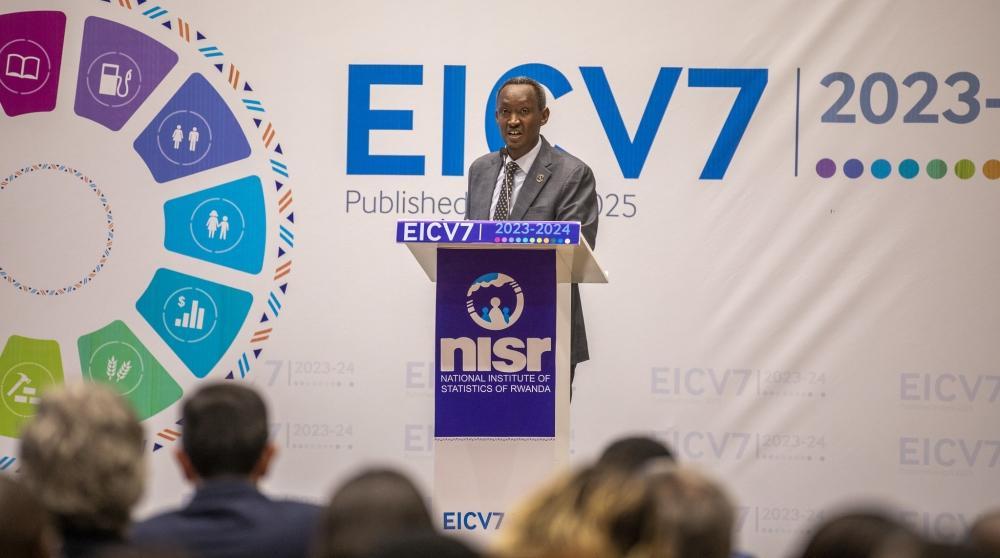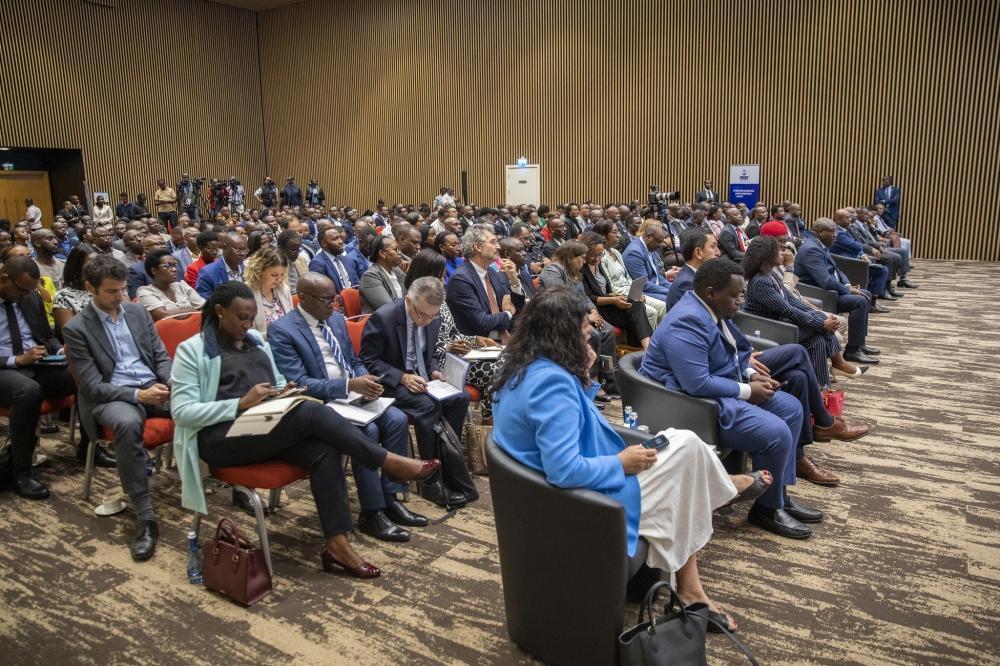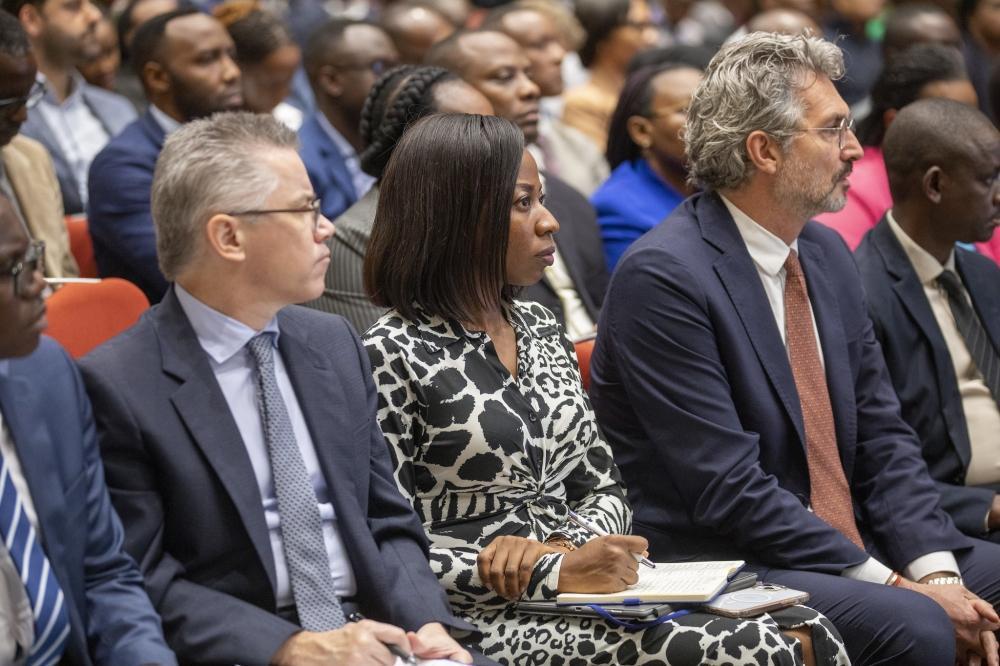Emmanuel Ntirenganya
Africa-Press – Rwanda. Rwanda has recorded a significant decline in poverty over the past seven years, lifting more than 1.5 million citizens out of poverty, averaging 214,000 individuals emerging from poverty each year, a new survey shows.
The seventh Integrated Household Living Conditions Survey (EICV 7), published by the National Institute of Statistics of Rwanda (NISR) on Wednesday, April 16, indicated that the national poverty rate fell from 39.8 per cent in 2017 to 27.4 per cent in 2024 – a drop of 12.4 percentage points.
Poverty in urban areas decreased from 18.8 per cent in 2017 to 12.7 per cent in 2024, a reduction of 6.2 percentage points, the report pointed out, adding that rural areas experienced a more significant drop, from 44 per cent to 31.6 per cent, indicating a reduction of 12.4 percentage points.
Prime Minister Edouard Ngirente described 1.5 million Rwandans who have been lifted out of poverty as an encouraging figure.
Delegates follow the presentation during the event
He said that poverty reduction and other achievements indicated by the survey report were realised over the seven years of implementing the first National Strategy for Transformation (NST1) – which was implemented from 2017 to 2024.
He stated that they were driven mainly by strategic investments made by the Government of Rwanda and its partners over the last seven years.
“Additionally, the long-standing social protection schemes played an important role in improving the well-being of our citizens,” he said.
“These efforts have also effectively contributed to the creation of income-generating activities and job opportunities in Rwanda, and it is a clear demonstration of the impact that can be achieved through good planning and effective implementation,” he added.
In particular, Ngirente said, the good speed of the country’s post-Covid recovery has led to increased employment opportunities, especially for the active workforce, including the youth.
This recovery has been aligned to growth in economic activities, estimated at an average growth of 9.1 per cent in the last four years of post-Covid pandemic, Ngirente said, adding that this was supported by good performance in most of the country’s major sectors.
“As we began our development agenda, we established a clear vision to ensure that every Rwandan benefits from our economic growth,” he said.
“In this regard, one of the key findings we observe is the strong correlation between the increase in household consumption and economic growth,” he said.
This relationship is a reflection of the steady improvement in income levels, employment opportunities, and social welfare initiatives, he pointed out.
“It also means that families are able to afford better nutrition, improved healthcare, quality education for their children, and an overall higher standard of living,” he said.
Regarding social protection, the report indicated that the survey data found that the number of Vision Umurenge Programme (VUP) – an integrated programme meant to accelerate poverty eradication, rural growth, and social protection, had around 410,000 beneficiaries.
VUP provides varied assistance to its beneficiaries, including through wages as payment for public works; and direct support or safety net through provision of unconditional monthly cash transfers to the needy.
Participants follow a presentation at the publication of the seventh Integrated Household Living Conditions Survey (EICV 7) report published by the National Institute of Statistics of Rwanda (NISR).
The support also includes financial services which consist of cheap loans charged at 2 per cent interest rate per year to help economically vulnerable people to run income-generating activities.
The analysis indicated that VUP interventions significantly target vulnerable populations, particularly women, pointing out that despite improvements, VUP households still lag behind in access to basic services compared to the general population.
Poverty rate remains high among VUP beneficiaries – 40.5 per cent, compared to the national poverty rate is 27.4 per cent – highlighting the need for enhanced strategies, particularly in employment-focused initiatives like Public Works, the report observed.
Much as the country has seen these good achievements, Ngirente said that it is mindful that it still has a lot do in its journey to become a poverty-free Rwanda.
Poverty indicators
While presenting the findings, NISR Director General Ivan Murenzi said that poverty measurement begins by establishing a poverty line. This includes both food and non-food needs—such as rent, housing, clothing, health, and education. But food is the key component.
In this regard, he said, experts set calorie requirements – to meet basic food needs – and corresponding costs.
The food poverty line, which determines extreme poverty, was set at Rwf356,000, while the general poverty line was set at Rwf560,000 per adult equivalent per year.
As such, 27.4 per cent and 5.4 per cent of Rwandans still live in poverty and extreme poverty, respectively as they fall below the corresponding lines. Those individuals are considered unable to afford life’s basic necessities, according to Murenzi.
Murenzi explained that the poverty line represents the basic food to be able work, though “not necessarily to be so healthy.”
Despite the impressive progress, Murenzi said that 27.4 per cent of Rwandans who still live in poverty represent “a tangible number” that calls for continued efforts and targeted policies to build on the country’s gains.
Source: The New Times
For More News And Analysis About Rwanda Follow Africa-Press








